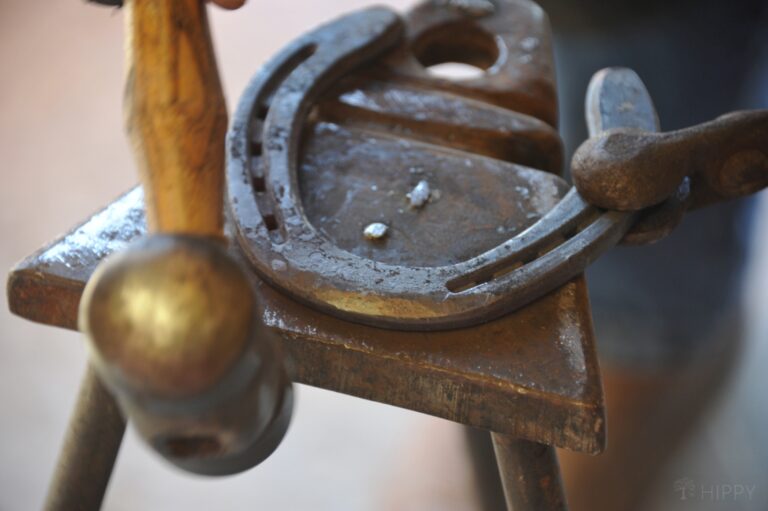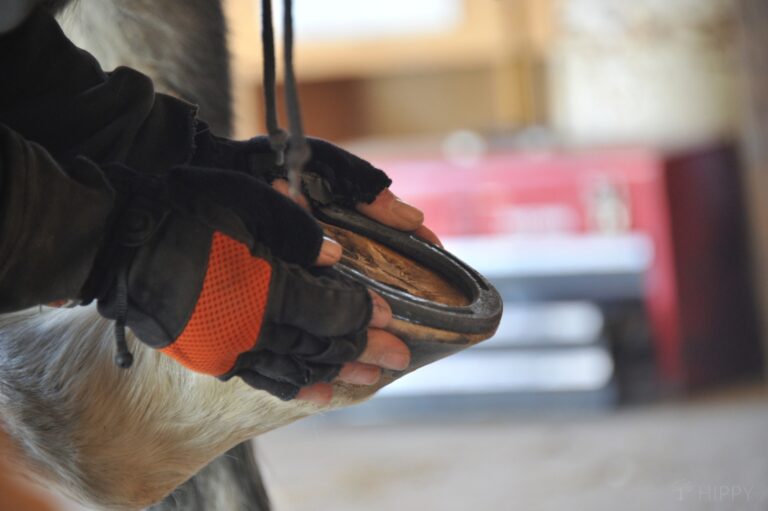It is a question that is nearly as old as recorded history. At first glance, it may seem like a silly question. After all, horses have been running around barefoot, or rather barehoof, for thousands of years.
But at some point in the distant past a horse was first shoed and they seemingly have been ever since.

Even today the battle rages about whether horses should be shoed at all. So, what’s the real answer: why do horses need shoes?
Horses need shoes to protect their hooves from the wear and tear of walking on hard surfaces or for additional grip on certain terrain. Horses may also need shoes to protect a thin sole, or a damaged foot from further injury.
It really is that simple. No more, no less. To be clear, though, not all horses need shoes, and not all horses that wear shoes need them all the time.
In fact, some veterinarians and hoof-care experts will tell you that shoes can do more harm than good if not used correctly.
But for the majority of horse owners, having their animals shod is the best way to protect their investment and ensure their horse’s comfort. It is a complicated subject, that’s for sure, so we’ll tell you more about it below.
Not All Horses Need Shoes, or Need Them All the Time
We should start by addressing the dissenters. There are those in the horse world who believe that shoes are unnecessary, and can even do more harm than good.
These individuals tend to fall into one of two camps. The first are those who believe that horses have evolved over millennia to deal with the conditions they find themselves in, and as such their hooves are perfectly adapted to their environment – be it soft grass or hard rock.
They maintain that shoes interfere with this natural adaptation, and can actually cause problems such as cracked hooves, abscesses, and other issues.
The second group consists of those who believe that farriery (the practice of shoeing horses) is an outdated and cruel practice that does nothing but inflict pain on the horse.
They believe that shoes restrict the blood flow to the hoof, and can actually make it more difficult for the horse to walk correctly.
This argument is based on the fact that horses in the wild seemingly very rarely need their hooves trimmed or shod, and therefore this must be an unnatural intervention.
So, there are two camps with very different opinions on whether horses need shoes or not. The truth is that not all horses need shoes, and may never need them.
But, as is often the case, the whole story is more complicated. It is true that some horses do not need shoes, and can get by just fine without them.
But for the vast majority of domestic horses, shoes are a “necessary evil”- and not really evil at all!
Horses that Work on Hard or Manufactured Surfaces Need Shoes for Protection
The simple fact is that most of us do not live in a natural environment where our horses’ hooves can roam free.
Instead, we live in a world of concrete, asphalt, and other man-made surfaces that are incredibly hard on hooves.
This is especially true for horses that work on these surfaces – such as racehorses, show jumpers, eventers, police mounts and dressage horses.
For these animals, shoes are an essential part of protecting their hooves and feet from the constant pounding they receive.
Even if your horse is not working on hard surfaces, though, they may still need shoes for protection.
In these cases, horseshoes can help to prevent further injury and keep the hoof from becoming sore or painful.
Horseshoes Can Protect a Hoof from Cracking or Becoming Injured
Sometimes, due to overwork, lack of proper nutrition, accident or even genetic factors, a hoof can become damaged.
The outer, hard part of a hoof is designed to protect the delicate tissues and bone inside the foot from injury.
Should a hoof become injured, shoes can help to protect the hoof from further damage and allow it to heal properly.
Applied correctly and in a timely fashion, shoes can even head off potential problems such as cracks, fractures, and the like. In short, shoes can help to keep a horse’s hooves healthy and prevent further injury.
Some Horses are Thin-Soled
Some horses, through no fault of theirs or yours, are simply born with thin soles or softer hooves.
This means that their hooves are overall not as tough and resilient as they could be, and are more sensitive and prone to injury.
In these cases, shoes are needed to protect the horse’s hooves from becoming damaged or the horse from feeling pain as it stands and walks.

A Horse’s Hooves and Feet Can Change from Disease or Injury
Something else to consider is that a horse might start out not needing shoes only to need them later on in life as it ages or after incurring an injury.
In these cases, the shoes are not necessarily needed all the time, but may be required during periods of active growth or healing.
Likewise, disease or lasting injury may necessitate a horse to wear shoes afterward die to permanent changes in the foot or hoof structure.
A Horse Might Need Shoes Only on Some Hooves
Perhaps most interestingly, a horse might only need shoes on its front legs, or even just on one leg.
This is due to the fact that horses’ gaits may be unevenly balanced, and therefore place more weight on one set of legs than the other.
In these cases, shoes help to even out the horse’s weight distribution and take some of the pressure off of the heavier-bearing hooves.
Different Horseshoes Can be Fitted for Different Purposes
When most people think of horseshoes, they picture the classic metal “U” shape that we are all familiar with.
However, there are actually many different types of horseshoes available, each designed for a specific purpose.
For example, there are shoes for dressage horses that have a longer toe and a higher heel to help the horse perform certain movements more accurately.
There are also racing plates, which are much lighter than traditional horseshoes and help the horse to run faster.
Shoes may be made of steel, aluminum, resin, plastic, leather or rubber, and can be fitted with a variety of different types of nails or screws.
Shoes can even be glued on! The type of shoe that is right for your horse will depend on its individual needs, as well as the surfaces on which it will be working.
Any Horseshoe Must be Properly Fitted to Work Safely and Effectively
No matter the shoe, proper fit is essential for the horse’s comfort and safety. A shoe that is too loose can rub and chafe the hoof, while a shoe that is too tight can cause bruising and pain.
An ill-fitting shoe can also work its way loose and come off, which can be dangerous for both horse and rider.
For this reason, any shoe must be fitted with skill and an understanding of all the relevant factors, such as the horse’s conformation, hoof shape and size, and intended use.
A good farrier will take all of these things into account when fitting a horse with shoes. You can certainly shoe your own horses, but you had better know what you are doing!
Any Shod Horse Should Have its Shoes Checked Routinely
A steel horseshoe seems incredibly solid once it has been fitted and nailed on to the hoof, but they don’t last forever.
Over time, the nails can work their way loose, or the shoes themselves can become worn down and need to be replaced.
For this reason, it is important to have your horse’s shoes checked and re-fitted on a regular basis, at least every six to eight weeks.
Your farrier will check the fit of the shoes and replace them if necessary. He or she will also trim the hooves and reset the shoes if they are okay but have become loose.
Tom has built and remodeled homes, generated his own electricity, grown his own food and more, all in quest of remaining as independent of society as possible. Now he shares his experiences and hard-earned lessons with readers around the country.
Find out more about the team here.
